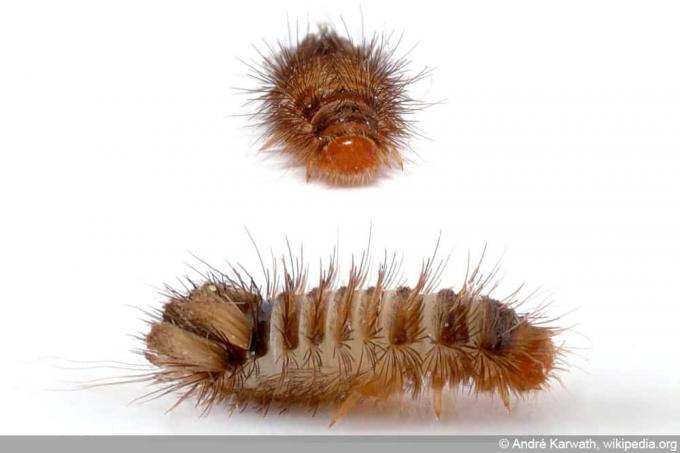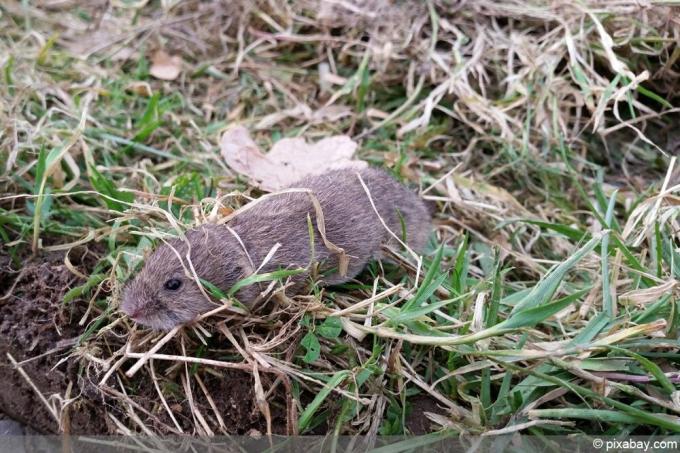

Table of contents
- Red worms, what can it be?
- House beetle (Opilo domesticus)
- combat
- Meal Beetle (Tenebrio molitor)
- damage picture
- combat
- Carpet beetle (Anthrenus scrophulariae)
- Possible habitats
- combat
- Willow Borer (Cossus Cossus)
- combat
- real worms
- Prevent red maggots / larvae
Anyone who discovers red larvae at home is guaranteed to feel uncomfortable. Worse, there could be health hazards. So it is clear that they must be eliminated. To do what against what?
Red worms, what can it be?
If you want to fight victoriously against an enemy, you must know who you are up against. It is extremely rare for real worms to get lost in your own four walls. Rather, different insect species can be responsible for reddish-colored or patterned larvae/maggots that we commonly perceive as worms. The four most common culprits are:
- house beetle (Opilo domesticus)
- flour beetle (Tenebrio molitor)
- carpet beetle (Anthrenus scrophulariae)
- willow borer (Cossus Cossus)
The unequivocal assignment of the find is important in order to be able to initiate targeted control measures. Because it is guaranteed not enough just to destroy the found maggots. The focus must also be on finding more specimens. It is also important to repair any damage that may have already been done.
House beetle (Opilo domesticus)
Although this species of beetle is predatory, it is not dangerous for us humans. The house beetle is even considered a beneficial insect because it devours the offspring of wood-gnawing beetle species. The coniferous forest is his habitat, alternatively also houses that have wood installed, for example in the roof trusses. Its thin, long larvae often have red or purple spots, giving them a reddish appearance from a distance. They are usually spotted near wood.
A notice:
You will hardly see the 7 to 12 cm large, dark brown beetle with light brown spots, because it is only out and about from June to August and is also nocturnal.
combat
Combat must be mandatory. But it is not directed against the house beetle and its offspring. Much more urgent and crucial is the control of the wood pest that attracted it as food. Not just to starve the house beetle. Wood pests can damage wood with the time factor and cause the roof structure to collapse. Identifying the wood pest and carrying out control measures require special knowledge and should be left to professionals.
Meal Beetle (Tenebrio molitor)

We know its offspring as mealworms, although this term is technically incorrect. The worm is a larva. That doesn't change the need to fight. The 20 to 30 cm long food pest is mostly white-yellowish. However, reddish colored specimens can also be found. The place of discovery is usually your own kitchen, more precisely a flour or grain package. Mealworms are often introduced with new, contaminated packages of flour. However, long storage times can lead to the pest multiplying, spreading and damaging untainted food.
damage picture
If you spot a red mealworm, you should immediately start looking for its source by examining dry food supplies. The following damage pattern is typical for the flour beetle and its offspring:
- Holes in flour bags and grain packaging
- threads in the flour
- sticky lumps of flour and cereal flakes
- large, clearly visible maggots
- black bugs inside and outside the packaging
combat
The kitchen cupboards must first be completely cleared out, then vacuumed and wiped with vinegar water. Collect and dispose of any found bug and worm specimens. All infested food must also be disposed of immediately and completely. Only put back food that is in good condition. After about 2 to 3 weeks, check all dry stocks a second time to nip any new infestation in the bud. Because it could be that insect eggs were overlooked.
Tip:
Act immediately when you spot mealworms. They can transmit harmful bacteria as well as dwarf tapeworms.
Carpet beetle (Anthrenus scrophulariae)

The carpet beetle is also known as the figwort flower beetle. Its offspring eat silk, wool, fur, leather or feathers and leave holes in them. They have the following external characteristics:
- length of about 6 mm
- reddish brown colour
- bright rings
- dense hair
- Arrow hairs on abdomen
Possible habitats
It is also true for carpet beetles that a single find makes further finds probable. Many objects in the home can serve them as food. The following list provides information on where to look more closely:
- Carpets (eponym)
- upholstered furniture
- Cover
- fabric curtains
- Clothing
Tip:
In the children's room you should not forget the cuddly toys in your search for this pest! In this way, you can stop a possible infestation at an early stage, even before your favorite animal gets bigger or worse. can cause irreparable damage.
combat
If carpet beetle larvae are in the house, you should not waste any time doing nothing. First of all, the specimens found must be collected and destroyed. Further measures depend on what is affected in the apartment.
- Thoroughly vacuum carpets and upholstered furniture
- ideally with a steam cleaner
- Clean wardrobes and bed frames with vinegar water
- a mixture of one part vinegar essence and four parts water is effective
- Wash curtains, blankets and clothes
- Freeze non-washable textiles/furs for several hours
- packed in plastic bag, at min. – 18ºC
Tip:
Do you have a mere suspicion that the carpet beetle is present in your rooms and up to mischief? Setting up a pheromone trap could provide the ultimate certainty.
Willow Borer (Cossus Cossus)

The larva of a willow borer has no place in an apartment. However, if there is a willow in front of the window or not far from it, which serves as food for the willow borer, a few specimens can get lost inside. The butterfly caterpillar is easily identified by the following features:
- yellow body color
- distinctive red coloring of the back
- approx. 10cm length
Tip:
If there is an intense smell of vinegar in addition to the characteristics mentioned, then you can be sure that you are actually dealing with a larva of the willow borer.
combat
You must expect willow borer caterpillars from August to May of the following year. Since the larva feeds exclusively on willow wood, it will not cause any harm in the house. However, she can defend herself well with her cutting tool if she gets into trouble. It cannot multiply indoors, so you do not have to worry about the infestation spreading. Still, it's understandable that nobody would want to have a caterpillar in their home. But it is not necessary to destroy the caterpillar. It can be easily picked up with a piece of paper or something similar and taken outside.
real worms
Small, larvae-like earthworm species that have a distinctive red coloration can be treated with potting soil or newly bought plants get into the apartment. They are usually well hidden in the ground, but can leave the flower pot and become visible. Especially when watered generously. Collect the earthworm and take it outside to the garden.
Tiny red worms can also be mosquito larvae brought in from the pool. They are not viable in air and pose no danger. Dispose of with gloves and then clean the site.
Prevent red maggots / larvae
An infestation cannot be completely ruled out. However, a few precautions can significantly reduce or at least limit the risk of infestation in some species.
- Close off access via doors and windows with insect screens
- Check inventories regularly
- possibly. Pour into tightly sealed containers
- Take infested food out of the house immediately and dispose of it
- Clean kitchen cabinets regularly
- Vacuum upholstered furniture and carpets regularly
- Check and wash natural fiber textiles regularly
- Protect wooden structures from wood pests with wood preservatives
- Do not use garden soil for indoor plants
 Home editorial office
Home editorial office
Learn more about home pests

Compost bin powder against maggots: this is how it works
Especially in the warm season they can hardly be avoided: maggots in organic waste. In addition to insecticides, there is a far better way to keep the annoying guests away: powdered organic waste bins. We tell you how to use it and how it works.

Combat earwigs | 5 remedies against earworms in the apartment
Although earwigs, Dermaptera in Latin, are completely harmless and actually useful animals, the insects are still a cause for panic for many people when they appear in the apartment. Here you can find out how to get rid of the unloved crawlers.

Ants in the brickwork: you can do that now
Ants are useful insects, if they are in masonry they can cause damage to an object. An infestation is not easy to recognize, but if the first signs appear, you should act immediately. Simple home remedies are usually sufficient to drive away the insects.

Identify and fight fleas in the home
Even the thought of fleas in the home is uncomfortable. After all, we associate uncleanliness with annoying insects. They are considered carriers of dangerous diseases. Where are you from? What are the signs of a flea infestation? How do you get rid of them?

Fighting maggots on the ceiling | 7 tips for all rooms
Bedroom, kitchen or pantry, wall or ceiling - anyone who discovers maggots in the house wants to get rid of them quickly. With our help, you can do it quickly and without professional pest control.

Fighting mice in the garden 8 tips against mouse holes
Suddenly the earth sags and the roots of the vegetable plants are bare? Then there is a high probability that mice have nested in the garden. Although the rodents cause a great deal of damage in the beds and on the lawn, the gardener is just as reluctant to kill them. Biological measures are the solution, because mouse holes can also be fought without chemicals.

